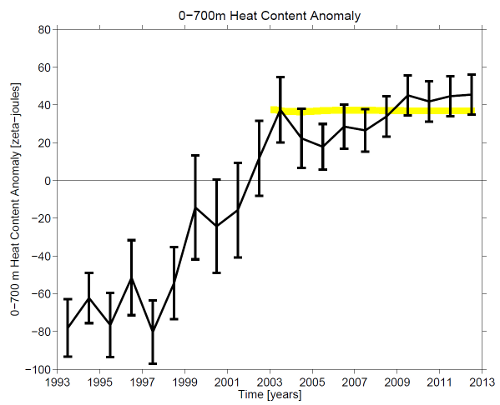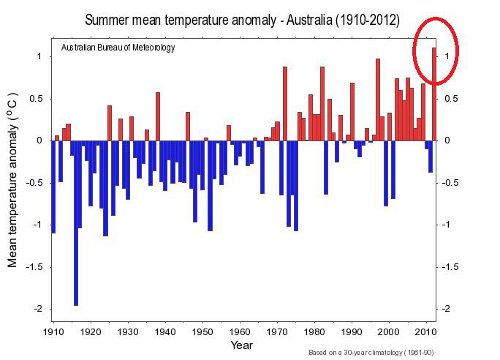The Climate Commission [CC] has been dogged by controversy since it was set up to explain the certainty of AGW. Its latest reports are no exception. The first report asserts [paragraph 2]:
the physics [of AGW] are very well understood
And then:
Advertisement
The vast majority of the extra heat does not go into the atmosphere and thus raise the air temperature but rather into the ocean.
But back-radiation of infra red radiation at CO2 absorbing and emitting wavelengths, the way AGW allegedly works, cannot penetrate the oceans.
Basically for heat from the atmosphere is to be "transmitted" to the ocean the temperature gradient must be atmosphere => ocean but global average atmospheric temperature is about 3 C COOLER than the ocean.
So even if the oceans are warming they are NOT warming due to AGW, even if AGW exists, and there is very strong evidence it doesn't. What this shows is even if it is a case of "the physics being very well understood" what is not understood is how the climate system reacts to the physics.
Are the oceans warming? The CC shows ocean warming to 700 meters and to 2000 meters in Figure 1. The heat accumulation at 2000 meters is problematic. The ocean warming to 700 meters is more important because this level has a strong relationship with energy leaving the atmosphere. The CC says the ocean is warming to 700 meters.
This is wrong and the CC's information is superseded by ARGO data from the NOAA Pacific Marine environment Laboratory (PMEL).
Advertisement

The second CC report is even more strident than the first and concerns itself with the records recently broken during the 2012-2013 summer. For the CC and the Bureau of Meteorology [BOM] the recent summer was the hottest on record. This is confirmed by the BOM's record of summer temperatures and the graph of summer temperature anomalies from 1910:

However the BOM also lists the summer temperature anomalies for all Australian States, Territories and Regions. Researcher Ken Stewart has done an analysis of these States, Territories and Regions. None of these 13 component areas of the Australian continent show a summer temperature record.
How can there be a continent wide summer record when no part of the continent had a record?
The problem is the BOM has not released the methodology of how it reached its conclusion that the summer was the hottest; or what climatic and weather causes were responsible for it, other than saying that AGW has caused it.
A possible explanation is put forward by Ken Stewart in his post. The summer record is based on the mean temperature which is the average of the combined maximum and minimum temperatures for the period. In his analysis Ken notes that no region had a summer record minimum temperature and only one region had a summer record maximum temperature, Southern Australia.
Southern Australia covers this part of Australia:

However when the temperature results at a State level are combined with the Regional results only a relatively small part of Southern Australian Region is left as being a possible source of the whole Southern Region's maximum temperature record:

The point Ken makes is that a record maximum in one part of Australia may have produced an overall summer mean record. If this is the case the summer temperature record is not based on a Nation-wide mean temperature heating event; it is based instead on a statistical extrapolation of a different temperature type which only has correlation with weather and climate causes in the area where the record occurred.
The BOM and the CC could make the point that there does not have to be a record in all the constituent parts of the nation; it is sufficient that it be hot enough everywhere for the record to be broken. Any particular records would be a bonus. To this end they list 123 alleged records during the summer covering temperature, rainfall, river heights and other "extreme events".
Ken Stewart has examined a few of the alleged records and discovered some dubious book-keeping. Ken refers to the 23 records shown in the eye-catching graph on page 3 of the report. He notes the CC appears to have specified 4 flood records including 2 from the Burnett River [Walla and Bundaberg 50 Km apart which would mean 2 records are claimed for the one event!]. The others are Laidley Creek, and the Clarence which produced the Grafton floods.
In the Brisbane River catchment alone, there are 40 separate streams, one of which is Laidley Creek. So, 1 out of 40 streams had a record height. And this was in the wet season. All the larger streams [Warrill, Lockyer, Bremer, Stanley, Brisbane] were not just below record but also below predicted heights.
These floods were terrible disasters and caused great trauma and economic loss for the places affected. However, the CC does the victims no good by telling less than the whole truth.
The Rockhampton and Kingaroy daily rainfall records are accurately reported and there were also some very big falls in the ranges behind the Rockhampton-Gladstone-Bundaberg area. However, none of the records came within 'cooee' of the record from Crohamhurst [BOM reference 40062] in 1893 of 907mm.
In addition the Mt Florance 220mm rainfall total, is a January record; it's all month record of 295mm occurred on 5/2/1993.
Similarly Maryborough's 258.8mm is not an annual record which remains at 359.9mm on 5/2/1931.
The record temperatures also fare badly. Canberra's ostensible 42.0 temperature record was surpassed by the Canberra Airport Comparison of 42.2 on 1/2/1968. Cape Naturaliste 37.7C on 30/12/2012 is only a record for December, with its all time record of 40.6C on 10/1/1978. And Birdsville's all time record of 49.5C on Christmas Eve 1972 still beats the January 2013 'record' of 49C.
So out of the 23 on the CC's featured page, 5 are not records, 2 refer to the one flood event on the same river only 50-60km apart, 1 is on a small tributary that had a geographically fluke flood while the rest of the catchment streams did not reach predicted heights. Eucla has no data before 1957 despite being open since the early 20th century, and 4 other temperature records are Australia wide records using the new method which can't be checked or replicated. At the very least 6 out of 23, more than 25%, are bogus. How many of the 123 are like that?
Apart from these instances where the CC and BOM cannot even get their own facts right there is the context of the alleged records. For instance Newcastle is listed as having a record temperature of 42.5C. This can be checked at the BOM site. It happened on Friday the 18/1/13. However on the same page the mean maximum for January is shown as being 26.9C. Compare that with the history of monthly mean maximum temperatures at Newcastle. The highest January maximum was in 1882 and the hottest period was before 1890.
The CC, BOM and ultimately the government would have us believe today is much hotter than the past. Such claims are based on misinterpreting their own data. If such basic facts cannot be presented correctly is it no wonder the official AGW science is also legitimately questioned?